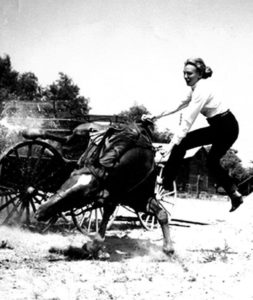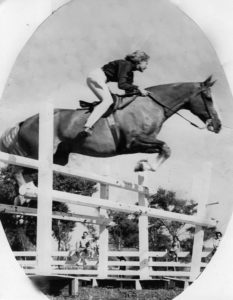Legendary Stuntwoman Talks Horsemanship

Martha Crawford Cantarini jumps from her horse, Jim, in a stunt gone wrong for a promotional shoot for the film, The Big Country (1958). Martha wrote an article about this experience in the Fall 2019 issue of Equus Magazine. (Photo from Martha Crawford Cantarini’s personal collection; used with permission)
Horsemanship is such a vital part of being a skilled farrier. In order to be successful at horseshoeing, farriers need to learn how to get along with the horse. When a farrier attempts to do the job without empathizing with the horse, there is inevitably trouble. To learn horsemanship, farriers should study the work and teachings of the masters.
This week, I had the opportunity to speak with one of the masters to get her take on what makes someone a better horseman. Martha Crawford Cantarini has had an incredible career as a stunt woman and horse trainer. She is humble, and would never describe herself as a master. She is most excited to talk about what horses have taught her. She has dedicated her life to learning how to get the most out of her partnership with the horses she worked with.
When asked how she did it, she simply said, “It’s a feeling. You can’t explain feel. Horses teach you what feel is. When you have a horse that is gentle and has a soft feel, you have to be that way to. If you be any other way, it won’t work…Horses size you up really quick. They can tell just what you know and what you don’t know.”
There is no substitute for experience when it comes to learning how to be a better horseman. Studying books on horsemanship is a great way to start learning how to be around horses, but that alone cannot make a better horseman.
Martha gained a great deal of experience, working with a wide variety of different types of horses in her career as a Hollywood stunt double. She worked on movies like Yellow Sky, Interrupted Melody, The Big Country, The Law and Jake Wade, Love Me Tender, My Friend Flicka and many, many others. Martha worked alongside actors Gregory Peck, Charleton Heston, Elvis Presley, Richard Widmark, Robert Taylor and Clark Gable. She doubled for Eleanor Parker, Anne Baxter, Shirley Maclaine, Debra Paget, Claudette Colbert, Jean Simmons and Patricia Owens just to name few!
Martha has been inducted into the Hollywood Stuntman’s Hall of Fame. She received the Golden Boot award for her achievements in Western Films in 2005. She has written several magazine articles over the years, including a recent article in Equus Magazine. (EQUUS, 498, Autumn 2019, pg 98-101)
However, Martha has always said of all the stars she has worked with, her favorites were her four-legged co-stars. She has worked with some of the best horses and horse trainers in the world. She says she was born with an aptitude for horses and that her father, Carl Crawford, hand-polished her skills.
To illustrate her point about the importance of feeling when riding and working with horses, Martha related a sad story about an actor who rode a horse to death once simply because he couldn’t feel that the horse was exhausted. Of this dark experience, she said there are happy memories and bad memories of her days working with movie stars.
I asked her why some people seem to be able to learn the feel she spoke of, and why others seemed to not be able to learn it. She said, “I think a lot of this is an ego thing…what I really believe is that these people who don’t get along with horses are technically afraid of them and they don’t want that to show it, so they pretend they don’t like them or the horse is no good, or whatever to cover up their own fear. They’re embarrassed by their fear.”
Martha trained a lot of horses over the years, including her famous horse, Frosty. I asked her what the key to training horses is. She said, “The key to it is immediate praise. What happens is some people will want [the horse] to do something and then five minutes later, they’ll praise him. The horse can’t connect that. You have to praise him right when he does it and then he learns really, really fast.”
She also related this philosophy to a common problem farriers might face. “Like if you’re going to stop a horse from kicking you. Say you’re bending over to put a shoe on the front foot and he’s going to cow-kick you with a back foot. Well, if you want to really stop him in a hurry, you have to correct him with a little whip while the leg is in the air—not after he puts it down and you’re jumping around holding your toe and then come back and kick him in the belly 3 minutes later. He can’t put that together. The trick is it has to be done at the time the action occurs…and he’ll learn it really fast. It’s amazing how fast they learn!”
The most important trait to be a better horseman, Martha believes, is to “smooth the hands.” “[You] have to learn how to have gentle hands. When you snatch a horse and you have strong hands, he’s going to hate you. Whether you learn to ride on your seat or your feet, you must have soft hands.”

Martha jumping Baldy in a spade bit illustrating the importance of light hands. (Photo from Martha Crawford Cantarini’s personal collection; used with permission)
In one dangerous experience (pictured above), Martha’s gentle hands not only saved her life, but the life of her horse. In a famous picture of a stunt gone wrong, Martha’s horse, Jim, tripped over a wagon as she was jumping it. As the horse went down, Martha leapt from the saddle and guided Jim away from the wagon wheel (where he likely would have broken his leg), by lightly holding the reins in one hand (in the picture you can see she only has a hold of the reins with two fingers!) and pulling the horse by the saddle horn with the other hand. “The saddle horn was where his center of gravity was and by pulling it, I was able to get him away from the wagon,” Martha said. Both Martha and Jim walked away from the accident unharmed thanks to Martha’s quick reflexes and light hands. It would have been easy to pull on the horse’s head in that situation and the alternative outcome could have been disastrous.
She also described this picture (left) as an illustration of the importance of light hands. In this picture, she is jumping her horse, Baldy with a spade bit!
Martha Crawford Cantarini turned 91 this week! She is a living legend, possessing a wealth of knowledge about horses. She is so humble and would be embarrassed to be described as a master horseman, but that is exactly what she is. I was honored to speak with her and to learn from her. You can listen to Martha talk about her experiences working with horses in the movies during Hollywood’s golden age here on the Farrier Focus podcast or you can subscribe to the Farrier Focus Podcast on iTunes or Stitcher.
Related Posts
-
Farriers perform a valuable service for people who care abou...Jan 15, 2010 / 0 comments
-
-
Last month we shod the horses and mules at Fort Robinson Sta...Jun 09, 2011 / 0 comments
Blog Categories
- Anatomy
- Best Business Practices
- Conformation
- Current Events
- Customer Service
- Draft Horse Shoeing
- Equine Soundness
- Essential Anatomy Kit
- Farrier Careers
- Farrier training
- Foal soundness
- Horse Care
- Horse Foot Care
- Horse Owner Tips
- Horsemanship
- Horseshoeing
- Horseshoeing History
- Iron and Forge Work
- Student Spotlight
- Uncategorized
- Veterinary Care
Blog Archives
Contact Us
Butler Professional Horseshoeing School
495 Table Road
Crawford, NE 69339
(800) 728-3826
jacob@dougbutler.com
Subscribe to Our Blog
Get Our Free e-Book!
If you think you want to become a farrier (or know someone who does), this book can help you make that decision. Horse owners will learn the importance of choosing a qualified farrier and how to select the “right” one.
[ Get the e-Book Now! ]
- Follow:
